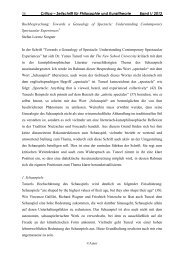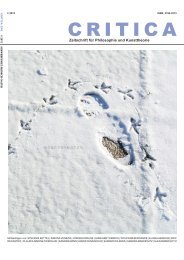Band II/ 2013 (7mb) - critica – zeitschrift für philosophie & kunsttheorie
Band II/ 2013 (7mb) - critica – zeitschrift für philosophie & kunsttheorie
Band II/ 2013 (7mb) - critica – zeitschrift für philosophie & kunsttheorie
Sie wollen auch ein ePaper? Erhöhen Sie die Reichweite Ihrer Titel.
YUMPU macht aus Druck-PDFs automatisch weboptimierte ePaper, die Google liebt.
CRITICA-ZPK<br />
<strong>II</strong>/ <strong>2013</strong><br />
can enter this first house, although<br />
the loud, red paint of the facade and<br />
a sign with a pair of scissors and the<br />
writing ”interdit” (forbidden) warns<br />
him from entering. Once the door<br />
is closed, all senses are bombarded:<br />
by flashily blinking light signals, by<br />
a gas tap on the ceiling from which<br />
Formol is escaping, by the sound of<br />
a motor on the ceiling, by prepared<br />
meals. The explosive aggressiveness<br />
in Psycho-Object. Maison which<br />
receives the other as intruder corresponds<br />
in Psycho-Objet 72. Autoportrait<br />
to a hermetically reserved conduct,<br />
because Jean-Pierre Raynaud’s<br />
Autoportrait is nothing else than a<br />
white coffin with one hatch instead<br />
of the head and four smaller hatches<br />
on the narrow side next to the feet.<br />
The jump from object to architecture<br />
is the logical consequence of<br />
his work which wants to expand to<br />
the room, a wish which has already<br />
manifested itself in his first installation<br />
of three hundred red painted<br />
flowerpots filled with concrete for<br />
the Kunsthalle Düsseldorf. The desire<br />
for Width is diametrically opposed<br />
to the claustrophobic narrowness<br />
in which Jean-Pierre Raynaud<br />
locks himself.<br />
From this situation, the permanent<br />
rebuilding understands itself as catharsis<br />
to identify oneself. He started<br />
in 1969, in the following year the<br />
interior is laid out with anonymous,<br />
white glazed tiles of 15 x 15 cm, including<br />
ceilings, excluding the floor.<br />
In 1972, the openings are gradually<br />
walled up until only a firing slit of<br />
five meters and sixty centimeters in<br />
length allows communicating with<br />
the outside world. A crypt develops<br />
whose access is denied by bars. In<br />
1974, the paint of the outside walls in<br />
Glasyd C. Fabre/Georges Duby, Jean-Pierre<br />
Raynaud , Paris 1986, p. 128 et. seq.<br />
khaki completes the impression of a<br />
shelter which is additionally delimited<br />
by a barbed wire from the neighboring<br />
fields. It offers Jean-Pierre<br />
Raynaud protection and security<br />
against any form of influence and<br />
means at the same time complete<br />
isolation. Death becomes the central<br />
topic and determines the character<br />
of the rooms; the bed room—so far a<br />
sick-room—becomes a death chamber.<br />
In the music chamber which<br />
resembles a sound insulated studio<br />
one year a single record is played:<br />
Mozart’s Requiem. Clinically clean,<br />
dehumanized, without any sign<br />
of life, let alone individuality, the<br />
house has reached the zero point<br />
(espace zéro). Like in the case of Absalon,<br />
its purpose is to find a form of<br />
survival.<br />
Fig. 5: Jean-Pierre Raynaud, La Maison, 1986<br />
In the following year, a process of<br />
dehumanization and revitalization<br />
of the house begins; it is repainted<br />
white and gradually opens again.<br />
Light penetrates and behind the<br />
bars, continuing the pattern of the<br />
tiles in the windows, nature displays<br />
colored atmosphere in strict white.<br />
New axes, other room proportions<br />
and the extension of a tower and a<br />
further tract confer upon it sacred<br />
character which goes hand in hand<br />
with its reanimation. An antique<br />
vase and some own flower pots are<br />
put in the foundation walls, to refill<br />
the house with human presence<br />
in the sense of its historical development.<br />
Jean-Pierre Raynaud has<br />
taken roots. The house has fulfilled<br />
its duty and can now be demolished.<br />
What remains are the Pierres<br />
archéologiques—broken pieces of<br />
the walls of glazed tiles which have<br />
been removed repeatedly—the single<br />
traces of his arduous search for<br />
his identity. They are the memory<br />
of a place, the trace of his personal<br />
story, souvenirs of his artistic development.<br />
Movement and continuity<br />
here do not designate a back and<br />
forth in the meaning of the Endless<br />
House, but the movement has a linear<br />
orientation forward and is a progression<br />
in time.<br />
With her works the American artist<br />
Andrea Zittel combines sculpture,<br />
architecture and industrial design.<br />
Her works can be associated with<br />
most of the mentioned artists. Zittel’s<br />
Living Units which she developed<br />
in the 1990s can be compared to Absalon<br />
since they as well constitute<br />
habitable sculptures which are exhibited<br />
in nature as well as in galleries.<br />
Like with Absalon they are prototypes,<br />
ideal living space in the narrowest<br />
of spaces. But, while Absalon<br />
is creating his white cells because<br />
of his need for motion and just for<br />
himself, Zittel produces living units<br />
out of industrially produced material<br />
for others. Her works are mass<br />
productions – what is indicated by<br />
the name of her “label” “A-Z Administrative<br />
Systems. Like already Adolf<br />
Loos had planned it partly, the interior<br />
design (room organisation and<br />
placing of furniture) are due to the<br />
architecture; within the Living Units<br />
every detail of the interior design<br />
8




